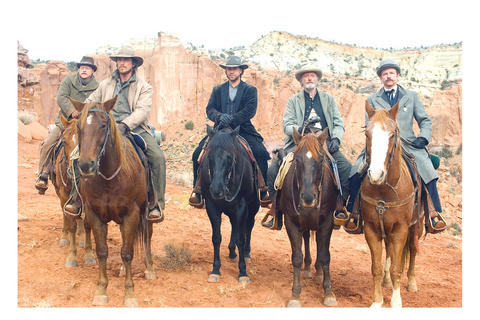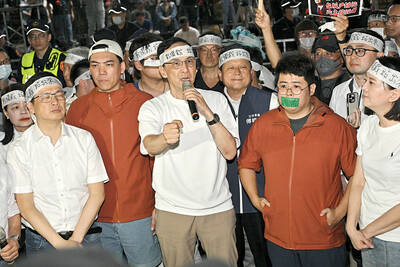Russell Crowe, who wears the black hat in 3:10 to Yuma, is a native of New Zealand. Christian Bale, the good guy, was born in Wales. Lou Dobbs and other commentators who have lately been sounding the alarm about outsourcing, immigration and the globalization of the labor market may want to take note. The hero and the villain in a cowboy movie: are we going to stand by and let foreigners steal these jobs? Are no Americans willing to do them?
Of course the western is a universal genre - one of the best recent examples, The Proposition, comes from Australia - and it must be said that Crowe and Bale both do excellent work. They and a fine, all-American supporting cast, including Gretchen Mol, Ben Foster, Dallas Roberts and a surpassingly grizzled Peter Fonda, are the main reasons to see 3:10 to Yuma, a serviceable addition to the current western revival.
Directed by James Mangold from a script by Halsted Welles, Michael Brandt and Derek Haas, 3:10 to Yuma remakes a 1957 film of the same title (based on the same Elmore Leonard story), which starred Glenn Ford as the charming baddie and Van Heflin as the rancher who risks everything to escort him to a rendezvous with justice.

PHOTO: AP
The original, directed by Delmer Daves, is a lean and satisfying specimen, a western more concerned with the psychology of its characters than with the mythology of the frontier. Mangold's new version, though it expands the story and cranks up the brutality, does its best to honor the unpretentious spirit of the original.
If it is a lesser movie - more likely to be recalled as a moderately satisfying entertainment than remembered as a classic - that may be a sign of the times. The best of the old westerns were dense with psychosexual implication and political subtext. Often dismissed, then and now, as naive celebrations of dubious ideals, they were in many ways more sophisticated than their self-consciously critical (or "revisionist") heirs. And the new 3:10 to Yuma, even in its efforts to stick to the old ways (apart from some obligatory post-Deadwood cussing), is neither spare nor suggestive enough. It lacks the confidence to distinguish between touchstones and cliches.
But the principal actors are nonetheless able to refresh their shopworn roles. Dan Evans, Bale's character, is a former sharpshooter in the Union Army trying to survive bad weather and predatory capitalism in the post-Civil War Arizona territory. Bale is one of the few screen actors who can convincingly shed the trappings of modernity. Dan is much more than a movie star in costume: with his gaunt, haggard face and wide, awe-struck eyes, he seems to have stepped out of a daguerreotype or a murder ballad.
Ben Wade, the prodigious robber played by Crowe, is a more familiar creature: a sociopath whose twinkly charm masks both his ruthlessness and his perverse integrity. Ben is better-humored than Dan, and he certainly looks better fed. He sweet-talks Dan's wife (Mol) and impresses Dan's older son (Logan Lerman), who regards his father's ineffectual uprightness with open contempt.
Dan signs on with the ragged, righteous entourage whose job is to take Ben over the mountains and put him on the train that gives the movie its title. It's not an easy commute. Ben's gang, led by his sadistic sidekick, Charlie Prince (Foster), is lying in wait, and there are plenty of other enemies as well, from angry Apaches to rival railroad tycoons. The West here is a Hobbesian realm where any two men will have at least three reasons to kill each other.
But Ben and Dan discover an unlikely bond, and Bale's haunted reticence plays well against Crowe's roguish relish. Their characters open up a bit too much toward the end, in confessional moments that soften the clean, hard contours of the story and bring to the surface themes that would have been more interesting if they had been left half-buried.
Mangold, whose previous films include Girl, Interrupted and Walk the Line, is not the kind of director who indulges in stylistic showboating. The action sequences in 3:10 to Yuma are effective and coherent, but it is the actors who carry the movie. The destination may be as familiar as the journey, but there are some sights worth seeing along the way.

In the March 9 edition of the Taipei Times a piece by Ninon Godefroy ran with the headine “The quiet, gentle rhythm of Taiwan.” It started with the line “Taiwan is a small, humble place. There is no Eiffel Tower, no pyramids — no singular attraction that draws the world’s attention.” I laughed out loud at that. This was out of no disrespect for the author or the piece, which made some interesting analogies and good points about how both Din Tai Fung’s and Taiwan Semiconductor Manufacturing Co’s (TSMC, 台積電) meticulous attention to detail and quality are not quite up to

April 21 to April 27 Hsieh Er’s (謝娥) political fortunes were rising fast after she got out of jail and joined the Chinese Nationalist Party (KMT) in December 1945. Not only did she hold key positions in various committees, she was elected the only woman on the Taipei City Council and headed to Nanjing in 1946 as the sole Taiwanese female representative to the National Constituent Assembly. With the support of first lady Soong May-ling (宋美齡), she started the Taipei Women’s Association and Taiwan Provincial Women’s Association, where she

Chinese Nationalist Party (KMT) Chairman Eric Chu (朱立倫) hatched a bold plan to charge forward and seize the initiative when he held a protest in front of the Taipei City Prosecutors’ Office. Though risky, because illegal, its success would help tackle at least six problems facing both himself and the KMT. What he did not see coming was Taipei Mayor Chiang Wan-an (將萬安) tripping him up out of the gate. In spite of Chu being the most consequential and successful KMT chairman since the early 2010s — arguably saving the party from financial ruin and restoring its electoral viability —

It is one of the more remarkable facts of Taiwan history that it was never occupied or claimed by any of the numerous kingdoms of southern China — Han or otherwise — that lay just across the water from it. None of their brilliant ministers ever discovered that Taiwan was a “core interest” of the state whose annexation was “inevitable.” As Paul Kua notes in an excellent monograph laying out how the Portuguese gave Taiwan the name “Formosa,” the first Europeans to express an interest in occupying Taiwan were the Spanish. Tonio Andrade in his seminal work, How Taiwan Became Chinese,